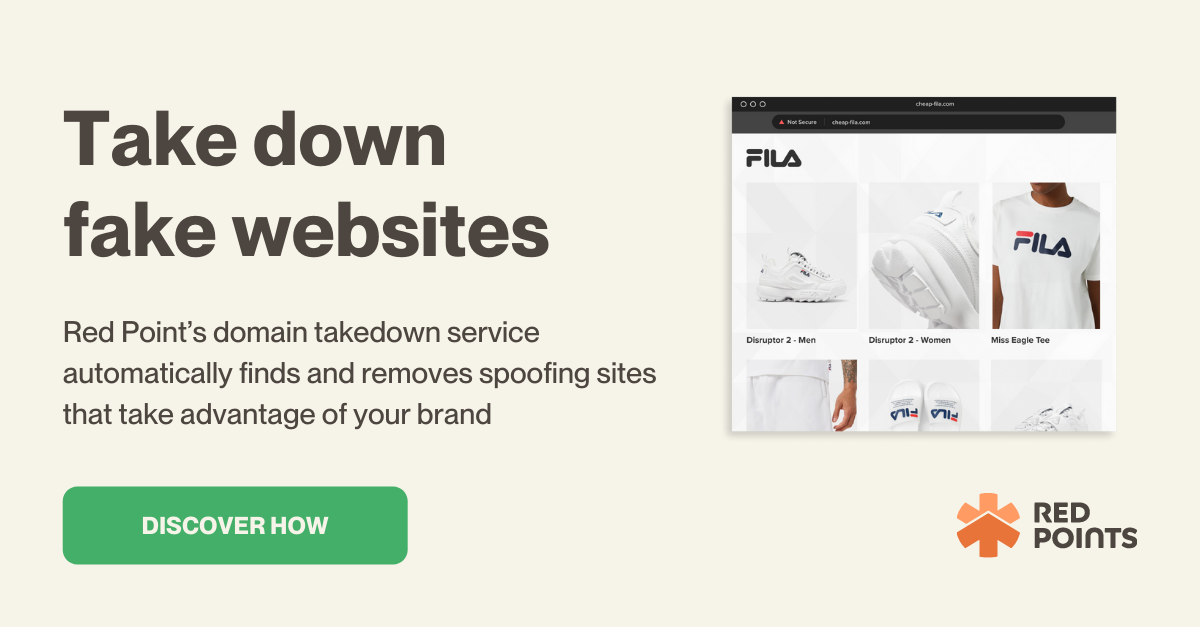
Table of Contents:
Last updated on: December 21, 2023
Over 12 million malicious websites are operating online today. Many of these will have been created by bad actors to take advantage of businesses and their customers. The scale and speed with which these scammers can operate, thanks to modern technology, presents many challenges to brands looking to safeguard their intellectual property and customer base.
In 2022 alone, Red Points detected 202,998 rogue websites and this number shows no sign of slowing down. So, what can brands do to combat this problem and protect their business?
Education and action are key. The more informed you are the easier it will be to take efficient and proactive defensive steps. In this blog, we’ll be exploring how to take down a malicious website by focusing on several topics, including:
A malicious website is a site that tries to infect your device with malware and steal data. They are a common tool used by cybercriminals looking for ways to mislead consumers.
Malicious websites pose a variety of threats to visitors including:

There is a diverse range of malicious websites. Some will masquerade as legitimate websites and try to fool visitors with their appearance and features. Others won’t hide their intentions with much sophistication and will instead make quite blatant attempts to steal your information and distribute malware.
In general, there are a few tell-tale signs that you are interacting with malicious websites. For example, malicious websites are often poorly designed and exhibit sub-par functionality. Buttons and animations will be inadequately constructed and sometimes won’t work at all.
You can spot a malicious website by its URL or domain name. Fraudulent websites may have suspicious URLs that have nothing to do with the content of the webpage. Equally, the URL or domain name might also contain strange words, phrases, or combinations of letters.
A malicious website will usually also be populated by fake reviews and testimonials. Some of these can be quite convincing in tricking people into thinking they are on a legitimate website. However, sometimes you can spot fake website content where there are obvious repetitions and blatant errors.
When you discover a malicious website you need to act fast to ensure it does not damage your brand or your customers.
Firstly, you should document any suspicious activity you see. You can accomplish this easily with screenshots and webpage archives. This documentation may become valuable evidence if you choose to pursue these malicious websites with any legal action in the future.
Start collecting evidence of any phishing emails or scam messages that get sent to you or your customers. These will also prove valuable if you need to show a regulator or law enforcement service when and how you first interacted with the malicious website. When it comes to fake website takedown this evidence is vital, so it pays to start collecting it as early as possible.
You can report a malicious website in several ways including Internet Service Providers and search engines like Google, Bing, and Yahoo!
You can track down a scammer by finding out their Internet Protocol (IP) address. Once you have this you will be able to learn about their Internet Service Provider (ISPs). You can then visit the ISP’s website and look for a ‘report abuse or fraud’ link, often found within the footer or on a Contact page. Through this, you will be able to report the scam website to the ISP. If you provide them with compelling evidence then they may be able to take down the malicious website for you.
You can also report domain registrars that may have allowed the scammers to initially purchase and register their domain names. You can report domain registrars to the Internet Corporation for Assigned Names and Numbers (ICANN). Submit the name of the domain registrar, the URL of the offending website, and any evidence of fraudulent activity.
Web hosting providers have a legal responsibility to remove illegal content if they are informed by the relevant legal authority to do so. Therefore, one path you can take to eliminate malicious websites is to report the hosting provider. You can do so via the Internet Crime Complaint Center (IC3) – the cybercrime arm of the FBI.
Finally, you can report malicious websites straight to search engines like Google, Bing, and Yahoo! All major search engines will have their own reporting and removal system that will be easy to use for businesses that are being attacked by bad actors. In the reports, you will usually be required to submit the URL, domain name, and evidence about the potential malicious activity.
If reporting a malicious website does not result in that website being taken down there are a few other steps you can take to safeguard your brand and customers.
For example, if you have registered intellectual property (IP) and you suspect the malicious website may have violated your IP then you can make a legal claim. Common legal claims in these scenarios include trademark infringement claims and copyright infringement claims. If your claims are supported by evidence then you will be able to legally pursue the creators of these malicious websites.
You can also send a cease and desist letter. This kind of correspondence can be sent to the creators of the malicious website as well as the domain registrars and the ISPs. A cease and desist letter is often the first step in a legal battle against infringers. It can also act as a deterrent to bad actors because it demonstrates your intentions to defend your IP.
Beyond letters and claims, you can also engage in a variety of domain dispute resolution processes to resolve the situation. The World Intellectual Property Organization (WIPO) is the global leader in domain name dispute resolution and a great resource for any business looking to subdue a malicious website. There is also a wide selection of independent alternative dispute resolution bodies that can assist your business when reporting malicious websites doesn’t work.
Red Points’ Domain Takedown Service is the ideal solution for a wide variety of issues your business may face when confronted by malicious websites. Our service will allow you to automatically find and remove websites that take advantage of your brand. We particularly support brands that are facing recurrent issues with malicious websites.
We have an 80% enforcement success rate on fake website removals and an average of takedown time of 1 to 7 days. And with over 1,200 clients we are experienced in providing a diverse range of solutions for all types of businesses faced with malicious attacks by scammers. Here’s how we do it:
Find
We detect and monitor fake websites on social media, search engines, and domain databases. Our bots search 24/7 to ensure that we can uncover any websites that may be trying to take advantage of your brand.
Validate
Once our service identifies potential malicious websites you can confirm or validate that the website is attacking your business. You can do this process manually or you can speed it up with automation based on the parameters you set.
Remove
Then we can move to report these domains and get them taken down on your behalf. Whether they are multi-brand or look-alike websites, we will quickly be able to report and remove any bad actors diverting traffic, selling counterfeits, or committing fraud.
As well as relying on smart, modern takedown services you can also take a few of your own steps to protect your revenue and customers from malicious websites.
Firstly, make sure that you register your IP and domain names on an international scale. Registering your trademarks in the United States will only protect you against attacks from scammers based on or operating in the US. Increasingly, we are seeing bad actors operate on a global scale while hiding in a variety of countries. One of the best ways to protect against the international nature of today’s scammers is to register your IP and domain names in a range of different countries.
Secondly, monitor your online presence. Look closely for any suspicious interactions or signs of malicious activity. For example, keep a close eye on your reviews page. If there are a host of bad reviews that mention strange and unusual issues this could be the result of your customers interacting with fraudsters rather than your actual products or services.
Finally, remember that you can’t do this alone. Instead, leverage automated technology and specialized solutions to speed up the process. If you try to rely on slow manual techniques you will become overwhelmed. This will make it more difficult to protect your customers and safeguard your brand. Smart, modern technology will help you streamline the process, save you a lot of time and keep you one step ahead of bad actors.
If you allow malicious websites to continue to evolve and impact your business, your ability to progress as a brand will be severely affected. Ultimately, to protect your business and your customers you have to learn as much as possible about malicious websites and be ready to act fast when you see them in operation.
If you have already been targeted by malicious websites then you need to start enforcing against these bad actors. You also need to communicate clearly with your customers and leverage social media to make the issue transparent to all those invested in your success.
Using a software provider, like Red Points, to automate the whole takedown process is the most effective way to deal with malicious websites that target your business. Then you will be able to hand over the complex monitoring, evidence-gathering, and removal process to experienced experts.
This will allow you to spend more time and resources on creative ideas that add value to your business. To learn about how Red Points can help your business remove malicious websites, request a demo here.
